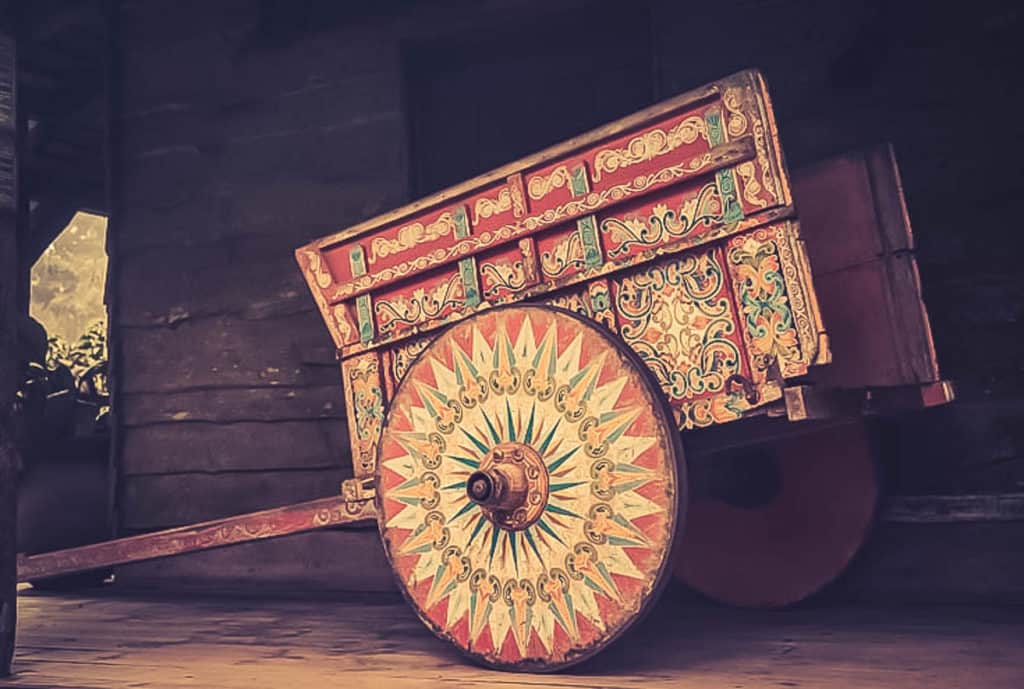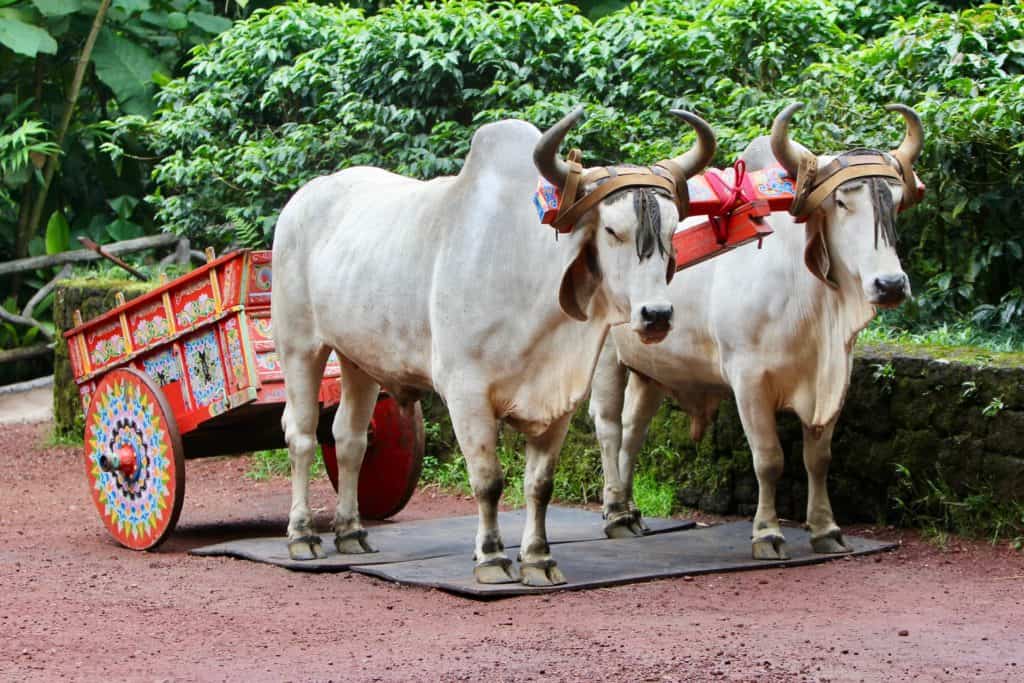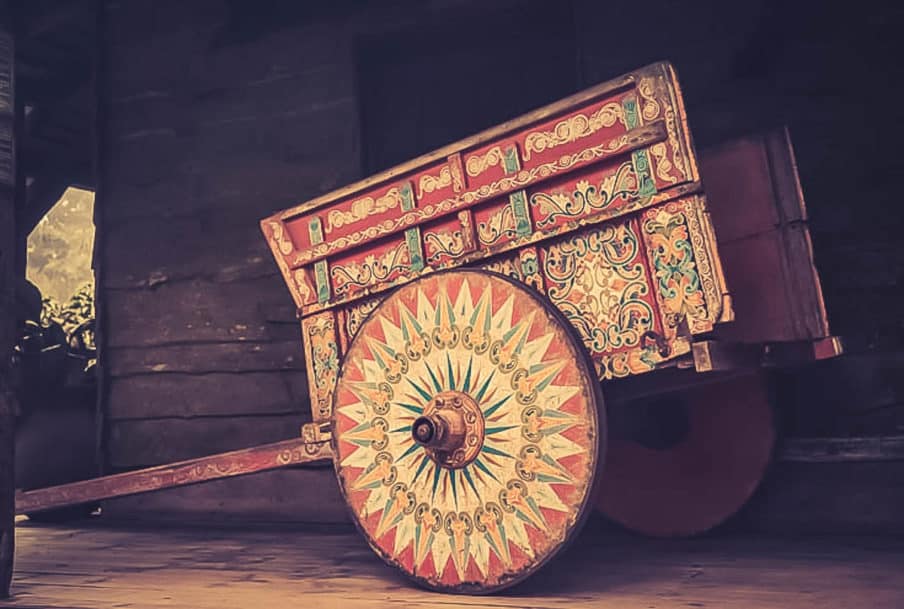
The Costa Rican ox cart, or “carreta,” is more than a traditional mode of transport—it’s a vibrant symbol of the nation’s heritage, embodying the spirit and resilience of its people. Known for their bright colors and intricate designs, these ox-drawn carts have evolved from practical tools to celebrated works of art, recognized as a National Symbol of Costa Rica since 1988 and an UNESCO Intangible Cultural Heritage since 2005. Whether you’re intrigued by their historical role in coffee transport or their starring role in modern festivals, this guide dives deep into the world of Costa Rican ox carts.
Today, we’ll explore what sets these carts apart, their past and present uses, and where you can witness their creation. Let’s embark on this colorful journey through Costa Rica’s cultural landscape.
What Is a Costa Rican Ox Cart Made Of?
In its simplest form, a Costa Rican ox cart is a two-wheeled, ox-drawn vehicle designed to haul people and goods across the country’s rugged terrain. Known locally as “la carreta,” it features a rectangular wooden body attached to a yoke for two oxen. The wheels, a standout feature, blend Spanish spoked designs with solid Aztec-style disks, creating a sturdy hybrid that excels in Costa Rica’s muddy, tropical conditions. Crafted from high-quality woods like cedar or mahogany, the cart’s durability was enhanced by iron rims around the wheels, a technique refined in the 19th century.
What truly distinguishes Costa Rican ox carts isn’t their construction but their decoration. Unlike ox carts worldwide, which Spanish colonizers introduced in the 16th century, Costa Rica’s versions became canvases for artistic expression. Hand-painted with vivid colors—think oranges, reds, and geometric patterns—these carts reflect regional identities and personal pride, a tradition that began in the early 20th century and continues to captivate visitors today.
How Are Ox Carts Used in Costa Rica?
While ox carts have largely been replaced by trucks and modern vehicles for everyday transport, their legacy endures in Costa Rica’s cultural fabric. In remote rural areas, some farmers still rely on them during harvest season or on terrain too rough for motorized alternatives. However, their primary role today is ceremonial. You’ll spot these vibrant carts in parades, religious festivals, and local celebrations like Día de los Boyeros (Oxcart Drivers Day) in San Antonio de Escazú, held annually on the second Sunday of March, where over 200 carts have been known to participate.
Each cart is a masterpiece, adorned with flowers, landscapes, faces, and geometric shapes in hues of orange, red, and beyond. Regional styles allow you to trace a cart’s origin—Sarchi’s designs differ from those of Cartago or Alajuela. A unique touch? Many carts “sing” as they move, thanks to metal rings striking the wheel hubs, creating a chime distinctive to each artisan’s craft. This blend of utility and artistry keeps the ox cart alive as a symbol of Costa Rica’s rural roots.
What Is the History of the Costa Rican Ox Cart?

The story of Costa Rica’s ox carts begins long before their colorful fame. In pre-colonial times, Indigenous groups like the Aztecs used hand-drawn carts, as oxen and horses were absent until Spanish colonizers arrived in the 1500s. These early European carts, with spoked wheels, struggled in Costa Rica’s muddy, mountainous landscape, often breaking or sinking. By the mid-19th century, local ingenuity fused Aztec solid-disk wheels with Spanish designs, birthing a robust carreta that could handle the terrain.
The ox cart’s golden age spanned 1850 to 1935, driven by the coffee boom. Coffee, Costa Rica’s economic backbone, needed transport from the Central Valley to coastal ports like Puntarenas—a grueling 10-to-15-day trek through jungles, swamps, and mountains. The carreta, capable of carrying up to a ton, became indispensable, with thousands in use at the industry’s peak. The first coffee shipment to London in 1843 relied on these carts, cementing their historical significance.
Painting emerged in the early 1900s, starting in Sarchi at the Joaquín Chaverri Oxcart Factory. Legend says Chaverri painted his family’s cart orange—using the only color he had—for Sunday outings, sparking a trend. By the 20th century, elaborate designs became a status symbol, with wealthier families commissioning intricate patterns. Post-World War II, railways and trucks diminished their practical use, but their cultural value soared, earning them National Symbol status in 1988 and UNESCO recognition in 2005.
Why Are Ox Carts in Costa Rica So Colorful?
The amazing colors of Costa Rican ox carts are more than aesthetic—they’re a cultural statement. Initially, painting served a practical purpose: lead oxide (minimum) in orange and red hues protected wooden wheels from tropical decay. But as the 20th century dawned, decoration evolved into an art form. Artisans like Joaquín Chaverri turned carts into expressions of pride, with designs reflecting local flora, fauna, and geometric flair.
This shift tied to social status. Wealthier families could afford time, paint, and skilled artists, resulting in ornate carts that stood out during festivals. Poorer farmers stuck to simpler designs, if any. Contests soon emerged, rewarding the most creative carts—not just for looks but for their “songs,” crafted from wheel chimes. Today, no two carts are identical, preserving a tradition of individuality and craftsmanship that dazzles locals and tourists alike.
The Town of Sarchi
Sarchi, nestled in Alajuela province, is the heartbeat of Costa Rica’s ox cart legacy. For over 120 years, this town has crafted carretas, earning its title as the birthplace of the painted ox cart. The Joaquín Chaverri Oxcart Factory, founded in 1902, and the Eloy Alfaro Oxcart Factory, established in 1923, remain active, producing about three carts monthly using traditional, near-machine-free methods. These workshops welcome visitors daily, offering a glimpse into the meticulous process—100 hours to build, 120 to paint.
Sarchi’s Central Park boasts the world’s largest ox cart, built in 2006 by the Alfaro factory, a Guinness-worthy marvel at 14.5 meters long. Beyond factories, the town’s handicraft market overflows with souvenirs—miniature carretas, furniture, and more—blending tradition with tourism. Nearby, Juan Castro Blanco National Park and Poas Volcano add natural allure, making Sarchi a must-visit stop near San José or Arenal.
Final Thoughts
Any trip to Costa Rica shines brighter with a visit to Sarchi, especially if you’re near Poas Volcano or Arenal. It’s a chance to step into history, witness artisans at work, and snag a handcrafted memento. The ox cart’s journey—from a coffee-hauling workhorse to a celebrated symbol of “Pura Vida”—reflects Costa Rica’s resilience and creativity. Whether you catch them in a parade or a factory, these rolling artworks offer a vibrant window into the nation’s soul.

